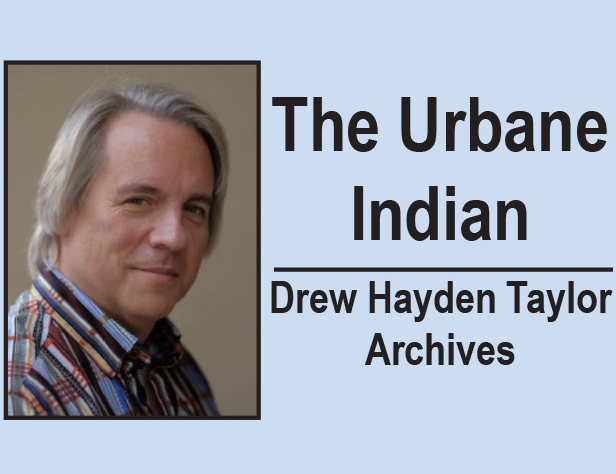
By Drew Hayden Taylor
Originally published in November 2010
One of funny man Charlie Hill’s best jokes deals with the Caucasian preoccupation with digging up or building on Indian burial grounds. Charlie Hill is the well-known Oneida comedian from Wisconsin who has been tickling the American funny bone with his Native humor for more than 30 years.
This particular joke goes something like “White people always blame Native people when their house is haunted, like when the walls start to bleed or their kids get sucked into the television set. I say that’ll teach you to build on an Indian burial ground, and I got news for you guys, the whole continent is an Indian burial ground.” Truer words were never spoken.
If we’ve been burying our ancestors here since Time Immemorial, every rock you see that’s bigger than your fist can be considered a tombstone. Yet, as local events prove, there always seems to be some confusion over what to do when developers, in the middle of putting up rows of split level duplexes, find their bulldozers digging up the remains of a Native village.
This happened just awhile ago in Vaughan, Ont. It seems that in a small soybean field just north of Toronto, two things were discovered. One–archeological remains of an ancient Aboriginal village, and two, a shocking what-can-only-be-called state of confusion over the proper way to proceed when evidence of prior Native occupation is discovered.
According to a recent article in the Toronto Star, this little patch of land is “thought to be on or near the site of a historically and culturally important Huron village from the 13th and 14th centuries.”
It’s only metres away from where, in 2005, the remains of some 400 Hurons were discovered when a local road was being widened. What a coincidence! It seems where there was once life, there was also death.
According to archeologist Keith Power, who was privately hired by the housing company to assess the archeological situation, “They (the housing company) didn’t want anything to hold this up. They wanted to go fast. They didn’t want to contact Aboriginal groups. That is clear.” The three-week excavation included ripping up the ground with bulldozers and earthmovers. You can almost hear the veins in the walls being severed.
Contemporary Huron officials only heard about the dig by accident and feverishly tried to get some Aboriginal involvement with the excavation, but with little luck. Calls to the Minister of Tourism and Culture went unanswered. The problem, as you may surmise, is there are no official guidelines on how to proceed in cases like this. I assume somebody could find the Aboriginal equivalent of Stonehenge or a great pyramid (made from birch bark, of course) and not worry about notifying local First Nations communities. It’s completely voluntary.
A spokesperson with the Huron-Wendat nation wants the province to ban the bulldozing of important Native sites by developers without consulting or even notifying First Nations people. The Ipperwash Inquiry found that approximately 8,000 Native villages and burial sites have been destroyed across the province of Ontario. If you’re not careful, that could result in a lot of children being sucked into their televisions.
Supposedly a new set of guidelines are “imminent,” according to Ministry of Tourism and Culture spokesperson Danelle Balfour. “The ministry is updating the standards and guidelines for archeology to bring more consistency and predictability. Aboriginal engagement will be a key part of the new standards and guidelines.” I think I read that in a treaty somewhere, but hope springs eternal.
I believe that in places like Mexico City, Rome and other cities that have a history almost as long as ours, there are clear and concise rules about what to do and how to proceed when coins, a charred rock, an ancient thimble or a thumb is unearthed, archeologists are immediately dispatched to investigate. In fact, I believe it’s law.
I wonder if the walls bleed in Rome? In places like London, I will admit I’m not sure if the local Celts or Druids are notified, but it’s worth investigating.
Of course, there’s the possibility that the uncovered bones of our ancestors might get too much attention. I remember when I was attending a conference in Oklahoma back in the early ’90s, I heard on the radio about a road crew that had unearthed some human remains.
It was then discovered that there were a combination of European and Aboriginal bodies from over a hundred years ago. It was decided to respectfully rebury the White remains, but send the Aboriginal remains off to the local museum to be examined. Sometimes you just can’t win.
Remember all this as your kids watch television tonight.
In case you’re curious, walls in First Nations communities seldom bleed. All the black mold usually scares the evil spirits away.
